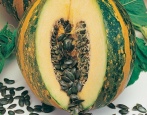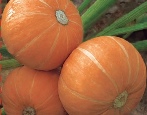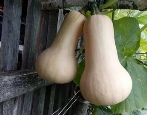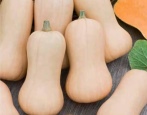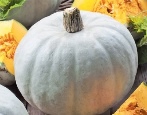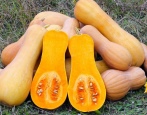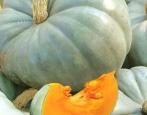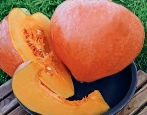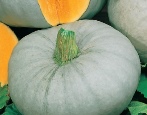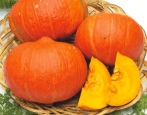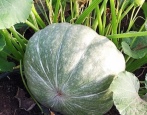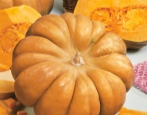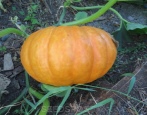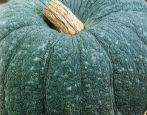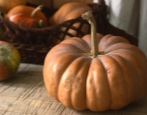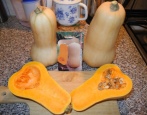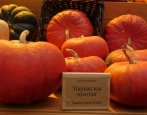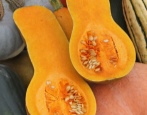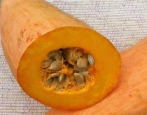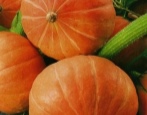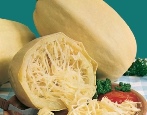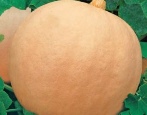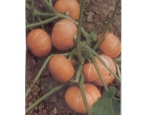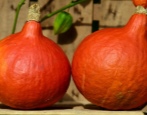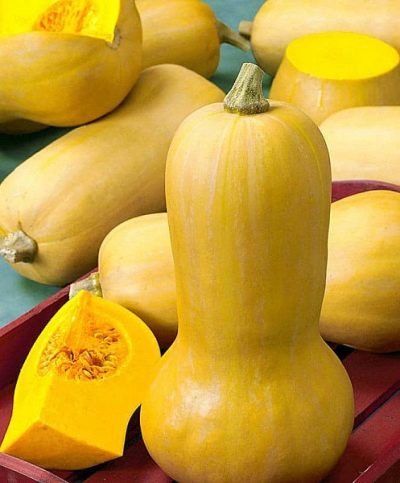
- Authors: Graham Dyche
- Name synonyms: Matilda
- Year of approval: 2009
- Growth type: strong
- The form: clavate (interception)
- Weight, kg: 3,5-4,5
- Coloration: yellow
- Color of the pulp: orange
- Pulp (consistency): starchy, dense, medium juiciness
- Taste: sweet
Butternut pumpkins have very interesting shapes and colors. The Dutch variety Matilda appeared in Russia more than 10 years ago, but has already firmly won positions on the plots.
Breeding history
The Matilda pumpkin is a hybrid produced in Holland. The breeder author is Graham Dyche. In 2009, the culture was allowed for mass use on the territory of Russia.
Description of the variety
Pumpkin, like all known melons and gourds, has a number of advantages and disadvantages.
Among the positive aspects are excellent taste, as well as the aroma of not only the pulp, but pumpkin as a whole. The variety perfectly tolerates short-term drought, while it is not a lover of arid soil. It easily adapts to different climatic conditions and continues to bear fruit even in light frosts.
The crop has good ripening times, as well as a strong immune system against fungal diseases.
The disadvantage is that the variety is hybrid, and there are practically no seeds in the pulp. This means that it will be impossible to breed a pumpkin on your own.
Characteristics of the appearance of plants and fruits
The bush is formed with long lashes. Their length ranges from 4 to 6 m, a strong type of growth is noted. A large number of female buds ripen on the lashes. Some of them fall off on the first day after flowering. The rest grow, develop and form future fruits.
Fruits are medium-sized, they are different in shape: clavate or pear-shaped and cylindrical. The mass of one vegetable is 3.5-4.5 kg.
The rind is not very segmented, yellow or light yellow in color. Rarely is a white color with a waxy coating. The skin is smooth, not thick. This characteristic makes it possible to transport the crop over long distances, while leaving a good appearance.
The fruit is firm, but can be easily cut with a knife. The pulp is elastic, starchy, dense. Her juiciness is average. A small seed chamber is formed inside the pulp, which is located at the bottom. There is a large amount of fiber in the chamber, and inside it there is a small amount of seeds.
After harvest, fruits are stored for up to 120 days.
Purpose and taste
Matilda pumpkin has a sweet, slightly sugary taste. The purpose of the vegetable is universal, so it can be used to prepare various dishes. This can be mashed potatoes, soups, or casseroles. Pumpkin is also used in cooking to create sweets or cakes.
Ripening terms
The culture is mid-season. The growing season is 110-130 days. Harvesting takes place from July to September. Pumpkins do not ripen well, so they are removed in several passes.
Yield
Summer residents note that with proper care, from 7 to 9 fruits can be removed from one bush. If you reduce the number of ovaries, then the pumpkins will form larger and heavier. On an industrial scale, there is a high yield, which averages from 696 to 940 centners per hectare.
Growing and caring
You can grow a pumpkin in two ways: seedling or seed.
The seedling method is suitable for regions with cold climates.In order to germinate a culture, it is necessary to prepare seedling boxes that are not too deep. They should be filled with soil that has been previously processed. Sowing begins in April.
Seeds are best treated with a weak manganese solution and dried on a napkin.
Shallow holes are made in the boxes, and one seed is placed there. Everything is covered with earth, and removed to a warm place.
Seedlings must be transplanted into open ground at the age of one month, provided that the ground temperature is at least + 18 ° C.
Sowing seeds in open ground. Previously, the site is well dug up and moistened with water, then holes are formed according to the scheme 100x60 cm.The depth of the hole should not exceed 6 cm.
Sowing of seeds is carried out in May-June.
Many summer residents argue that it will not be possible to harvest a good harvest without proper care. Care should include watering, loosening and fertilizing. There should be plenty of lighting.
It is necessary to plant seedlings according to the scheme, avoiding large thickening.
The first watering is carried out immediately after planting seeds or seedlings. The next irrigation is carried out after 12-14 days. This will help the root system to quickly take root in a new place, and sprout new shoots. Further, watering is carried out only once a week in a normal, not arid climate.
On average, 1 m2 should have from 4 to 6 liters. During the flowering period, the amount of water increases to 10 liters.
Do not water the flowers or leaves, this can lead to fungal diseases.
Matilda pumpkin is fed 2 times per season. Among fertilizers, it is best to use ash, mullein, bird droppings or mineral complexes that include potassium, phosphorus, fluoride. The increase or intensity of fertilizing should be due to the lack of minerals in the soil itself. Otherwise, there will be a strong oversaturation, which will lead to active growth of foliage, but not ovaries.
The Matilda variety is famous for its immunity, but with improper care and thickening of seedlings or herbs, pests or diseases can appear. It is necessary to process all tools that will interact with the soil.
In order to avoid the appearance of pests, the grass is removed not only in the beds, but also in the furrow. Extra shoots and foliage are removed. For prevention, the plant is sprayed with soapy water through a spray bottle. If pests are found, it is worth spraying with preparations that contain copper, or fungicides.
And also the care of the crop includes its correct collection. In the southern regions, the first vegetables will appear after 3 months, and after harvesting, new ovaries will begin to form on the bush. In cooler regions, it is best to harvest the entire crop before frost.
All fruits are harvested during the period of technical ripeness. These pumpkins will contain a lot of starch and become unusable. Therefore, they are removed to a dark and dry place until they are fully ripe. The temperature at which vegetables are stored should be no more than + 3 ° C.
